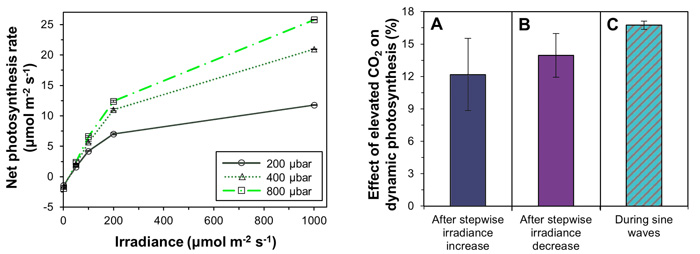| Follow @co2science |
Paper Reviewed
Kaiser, E., Zhou, D., Heuvelink, E., Harbinson, J., Morales, A. and Marcelis, L.F.M. 2017. Elevated CO2 increases photosynthesis in fluctuating irradiance regardless of photosynthetic induction state. Journal of Experimental Botany 68: 5629-5640.
The amount of light incident on a leaf's surface fluctuates in response to movements by the sun, clouds, the plant canopy or from the plant's leaf itself. Such fluctuations impact photosynthesis, as the processes that control photosynthesis operate on timescales of seconds to minutes and are influenced by changes in irradiance (i.e., changes in photosynthesis are not instantaneously achieved in response to sudden changes in irradiance).
In an intriguing study, Kaiser et al. (2017) set out to determine if elevated atmospheric CO2 concentrations would impact the level of photosynthesis in plants under conditions of fluctuating irradiance. More specifically, they investigated the effect of CO2 on (1) photosynthesis increase following a step-wise increase in irradiance to 1000 µmol m-2 s-1, (2) photosynthesis decline following an irradiance decrease, and (3) rates of photosynthesis (increase and decrease) during sinusoidal changes in irradiance (i.e., fluctuating irradiance).
To accomplish their objective, the team of six researchers analyzed the photosynthetic response of tomato leaves (Solanum lycopersicum, cv. Cappricia) in the controlled-environment chamber of a LI-6400 photosynthesis measurement system, exposing individual leaves to a combination of three CO2 concentrations (200, 400 and 800 ppm) and four irradiances levels (0, 50, 100 and 200 µmol m-2 s-1).
Results of the experiment revealed that net photosynthesis responded positively to both increases in atmospheric CO2 and irradiance (see Figure 1, left panel). What is more, the authors report that elevated CO2 also enhanced "the dynamic response of photosynthesis to a change in irradiance, regardless of initial photosynthetic induction state, and that it [did] so to a considerable extent (by 12-17%)" (see Figure 1, right panel), which effect, they say, "is additional to the positive effect of elevated CO2 partial pressure on steady-state photosynthesis rates" that is seen in the Figure 1, left panel.
Consequently, in light of the above findings, Kaiser et al. conclude that "future increases in ambient CO2 partial pressure may therefore benefit carbon assimilation of differently induced leaves in naturally fluctuating irradiance." And that is great news for plants struggling to receive their fair share of light!

Figure 1. Left Panel: Steady-state response of the net photosynthetic rate to irradiance at three CO2 levels. Right Panel: Effects of elevated CO2 partial pressure (800 µbar, compared with 400 µbar) on the dynamic response of net photosynthesis to changes in irradiance. (A) Effects on the rate of relative increase in photosynthesis rate until 15 min after a stepwise increase in irradiance. (B) Effects on the loss of photosynthetic induction until 15 min after a stepwise decrease to background irradiance. (C) Dynamic response at 1 min and 3 min periods, relative to dynamic response at the 5 min period. Source: Kaiser et al. (2017).




